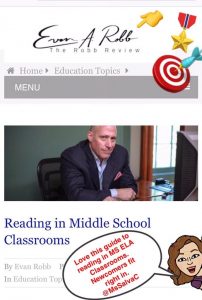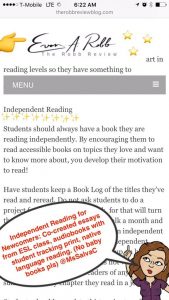Newcomers and SIFE mastering grade level ELA standards? What if they had limited formal education? They can. Our SIFE (Students with Limited or Interrupted Formal Education) are every bit as intelligent as the rest of the class. Their foundational literacy skills (decoding, sight words, etc) will come more quickly if they have the same opportunities for reading as their peers. This post focuses on reading in mainstream ELA classes. A follow-up post will focus on writing.
To illustrate accommodations for SIFE & non-English readers, I have received permission to reprint the following blog post from Evan Robb. Evan is an author, a principal , and a public speaker. My background is in ELA so I follow his blog, the Robb Review, closely and recommend it to all ELA teachers.
Evan’s background is such that his reading suggestions already include differentiation but for the purposes of this article, I have made annotations with #booksnaps so that the accommodations for SIFE are highlighted:
Reading in Middle School Classrooms
by Evan Robb @ERobbPrincipal
Popcorn reading, bump, and round robin reading do not make for great middle school classrooms! Often I am asked what types of reading should occur in a middle school English classroom? Three types or reading should be part of every middle school Language Arts classroom.
Instructional Interactive Read Aloud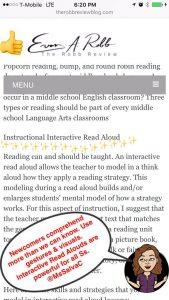
Reading can and should be taught. An interactive read aloud allows the teacher to model in a think aloud how they apply a reading strategy. This modeling during a read aloud builds and/or enlarges students’ mental model of how a strategy works. For this aspect of instruction, I suggest that the teacher models with a short text that matches the genre and/or theme that ties a reading unit together. Short texts can include a picture book, an excerpt from a longer text, a folk or fairy tale, myth or legend, a short, short story, or an article from a magazine or newsletter.
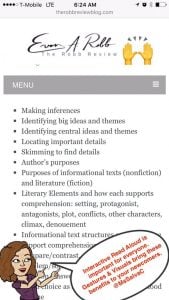 Here are some skills and strategies that you can model in interactive read aloud lessons:
Here are some skills and strategies that you can model in interactive read aloud lessons:
- Making inferences
- Identifying big ideas and themes
- Identifying central ideas and themes
- Locating important details
- Skimming to find details
- Author’s purposes
- Purposes of informational texts (nonfiction) and literature (fiction)
- Literary Elements and how each supports comprehension: setting, protagonist, antagonists, plot, conflicts, other characters, climax, denouement
- Informational text structures and how these support comprehension: description, compare/contrast, cause/effect, problem/solutions, sequence, question/answer
- Word choice as a guide to pinpointing mood or tone
- Vocabulary building with an emphasis on general academic vocabulary, figurative language, and comprehension, using roots, prefixes, suffices, discussing concepts, diverse word meanings, and different forms of a word.
Instructional Reading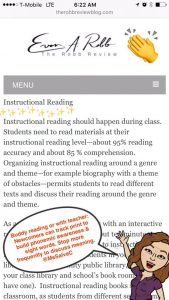
Instructional reading should happen during class. Students need to read materials at their instructional reading level—about 95% reading accuracy and about 85 % comprehension. Organizing instructional reading around a genre and theme—for example biography with a theme of obstacles—permits students to read different texts and discuss their reading around the genre and theme.
As an example, the class opens with an interactive read aloud lesson that lasts about ten minutes and occurs daily. Next, a transition to instructional reading. Find books for students in your school library, your community public library, and in your class library and school’s book room (if you have one). Instructional reading books stay in the classroom, as students from different sections may be using the same materials each day.
A teacher can have students chunk instructional texts by putting a sticky note at the end of every two to three chapters. When students reach a sticky note, they stop to discuss their books with a partner and then a group of four. During this stop-to-think time, students can write about their books, connect the theme to the book, and apply strategies and skills the teacher has modeled during interactive read-aloud lessons.
Partners should be no more than one year apart in reading levels so they have something to contribute to each other. Students reading far below grade level learn with the teacher.
Independent Reading
Students should always have a book they are reading independently. By encouraging them to read accessible books on topics they love and want to know more about, you develop their motivation to read!
Have students keep a Book Log of the titles they’ve read and reread. Do not ask students to do a project for each completed book, for that will turn them away from reading. A book talk a month and a written book review twice a year on independent reading is enough. Reflecting on independent reading is important; getting hung up on how you will hold students accountable is not very valuable. Remember, enthusiastic readers of any age do not summarize every chapter they read in a journal.
Students should complete thirty minutes of independent reading a night, and that should be their main homework assignment. Try to set aside two days a week for students to complete independent reading at school. Reading in a classroom is valuable!
Including the three layers of reading into a middle school curriculum brings balance, engagement, and motivation to the curriculum and holds the potential of improving reading for all students. When the teacher models how she/he applies a skill or strategy to a specific text, the teacher provides opportunities for all students to observe how a skill or strategy works. Instructional reading asks students to apply specific skills and strategies to texts that can improve students’ comprehension, vocabulary, and skill because these texts stretch students’ thinking with the teacher, the expert, as a supportive guide. Equally important is independent reading: easy, enjoyable texts that students self-select on topics, genres, or by authors that interest them—texts about two years below students’ instructional level.
Give this framework a try. The goal is to increase reading and help students learn how to become strategic readers.
![]()
Special thanks to Evan Robb for writing such a great article on inclusive reading best practices. Evan and I communicated briefly to be sure we were on the same page about accommodations for newcomers. I feel that this is a great example of how the mainstream and ESL teacher can collaborate virtually in support of our students who are SIFE.
